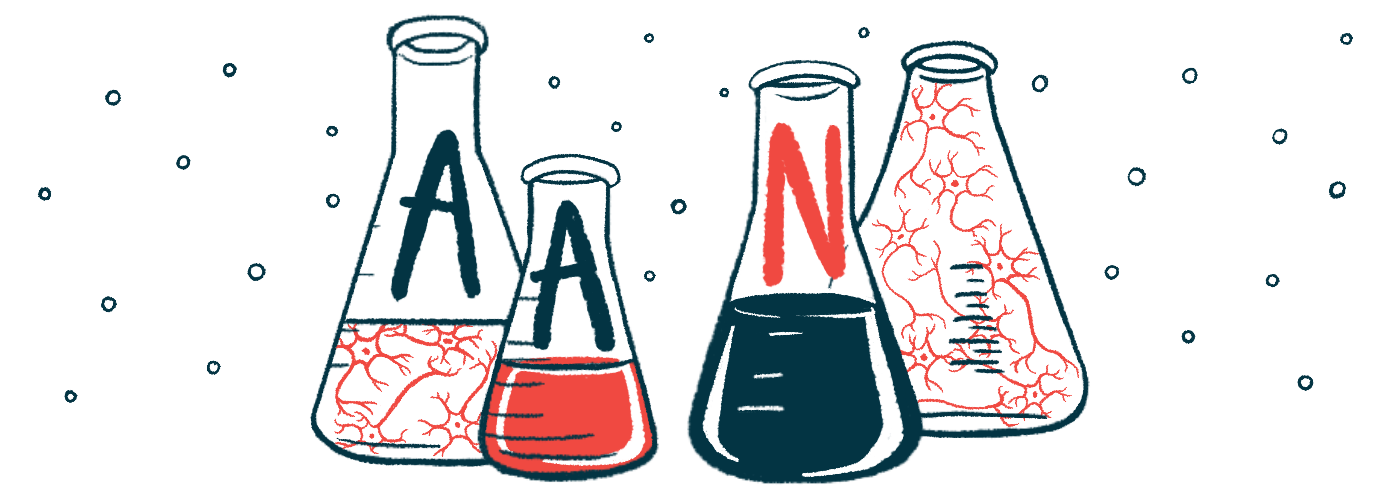AAN 2023: Onpattro, Amvuttra reduce levels of nerve damage marker
Research targets neurofilament light chain in familial amyloid polyneuropathy

Treatment with Onpattro (patisiran) or Amvuttra (vutrisiran) leads to a reduction in blood levels of neurofilament light chain (NfL), a nerve cell damage marker, among people with familial amyloid polyneuropathy (FAP), according to a new analysis of clinical trial data.
Findings suggest that patients with a greater reduction in levels of this damage marker also tended to report a more substantial easing of neurological symptoms following treatment.
“Collectively, these results support the utility of NfL as a biomarker of disease severity, disease progression, and treatment response over time,” said Michael Polydefkis, MD, of the Johns Hopkins University School of Medicine, in Maryland. Polydefkis presented the findings at the 75th American Academy of Neurology (AAN) annual meeting, being held April 22–27 in Boston, Massachusetts, and virtually.
The presentation was titled “NfL Levels Significantly Decrease in Response to Treatment with Patisiran or Vutrisiran in hATTR Amyloidosis with Polyneuropathy.” The work was funded by Alnylam Pharmaceuticals, which markets both Onpattro and Amvuttra.
Also known as hereditary transthyretin amyloidosis (hATTR) with polyneuropathy, FAP is caused by mutations in the TTR gene that lead to the production of an abnormal transthyretin protein. This faulty protein forms toxic clumps in the body’s tissues, causing damage that drives symptoms.
FAP is particularly marked by polyneuropathy, or damage to nerve cells outside the brain and spinal cord, resulting in symptoms like numbness, abnormal sensations, and trouble with coordination.
Approved FAP therapies
Both Onpattro and its longer-lasting successor Amvuttra are approved FAP therapies designed to reduce production of the abnormal transthyretin protein. Onpattro is given every three weeks via infusion into the bloodstream, whereas Amvuttra is administered through under-the-skin injections every three months.
Onpattro’s approvals were supported by data from the Phase 3 APOLLO clinical trial (NCT01960348), which tested the medication against a placebo in 200 adults with FAP. Approvals of Amvuttra were based on another Phase 3 trial, called HELIOS-A (NCT03759379), which compared Amvuttra against Onpattro in 164 adults with FAP.
Now, Polydefkis and colleagues analyzed data from the APOLLO and HELIOS-A studies to assess the impact of either treatment on patients’ blood NfL levels.
NfL is a structural protein that helps to support long, wire-like nerve fibers. When nerves become damaged, this protein leaks out into the surrounding bodily fluids. As such, NfL is widely used as a general marker of nerve injury, and has been suggested as a potential biomarker of disease progression and treatment response in FAP.
Elevated NfL levels
Results showed that at the start of either trial (baseline), FAP patients had significantly higher blood NfL levels when compared with a group of healthy people age- and sex-matched to APOLLO participants.
“Both APOLLO and HELIOS subjects had elevated NfL,” Polydefkis said.
Also, there was a moderate association between higher NfL levels and more severe polyneuropathy symptoms at baseline among HELIOS-A participants, “suggestive of NfL being an indicator of disease severity,” Polydefkis added.
Among FAP patients given a placebo in the APOLLO trial, there was a significant increase in blood NfL levels over the course of the study. Compared with baseline, average NfL levels increased by 19 picograms per milliliter (pg/mL) at four months, and by 36.3 pg/mL at 18 months (about 1.5 years).
By contrast, Onpattro-treated patients in the APOLLO study showed a significant reduction in blood NfL levels, by an average of 20.4 pg/mL at four months and 23.2 pg/mL at 18 months.
Similarly, in the HELIOS-A trial, average blood levels of NfL were decreased significantly among patients treated with either Onpattro or Amvuttra. At four months, levels dropped by 9.7 pg/mL with Onpattro, and 11 pg/mL with Amvuttra. By 18 months, the average decrease was 16.4 pg/mL for the Onpattro group and 19.9 pg/mL for those on Amvuttra.
“The three treatment arms, one from APOLLO, two from HELIOS, saw a reduction in NfL levels by four months and this persisted throughout the study till 18 months,” Polydefkis said.
‘Biological evidence’
He added that these findings “provide biological evidence that reinforces the demonstrated clinical efficacy” of Onpattro and Amvuttra in FAP.
Statistical tests showed that in both trials patients with a larger decrease in blood NfL levels by 18 months also tended to report a greater reduction in their polyneuropathy symptoms, as measured by the modified Neuropathy Impairment Score +7 (mNIS+7).
“The patients who saw the greatest improvement in mNIS+7 also saw the greatest improvement in NfL levels,” Polydefkis said, suggesting that “the degree of reduction in NfL may be associated with the level of improvement in [polyneuropathy].”
“These results suggest that NfL is potentially useful for monitoring treatment response and disease progression in patients with hATTR amyloidosis with polyneuropathy,” the researchers concluded.







